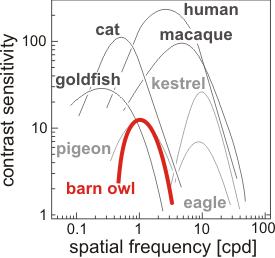[Disparity sensitivity] [Absolute sensitivity]


Download video
A view into the experimental booth. The owl has to push one of two response bars upon stimlus onset (here: horizontal grating) . Correct responses are rewarded by food items
| [Owl Cam] [Ocular aberrations] [Contrast sensitivity] [Vernier acuity] [Disparity sensitivity] [Absolute sensitivity] |
|||||||||||||||||
|
|
|||||||||||||||||
| The contrast sensitivity function of the barn owl | |||||||||||||||||
| project completed | |||||||||||||||||
| One of the fundamental functional descriptions of a visual system is the spatial contrast sensitivity function (CSF). The CSF, if measured behaviourally, describes up to which minimal contrast the observer can perceive spatial gratings of different spatial frequencies presented on an otherswise uniform background (see figure below). The CSF, then, incorporates visual function of both physical (i.e. the transfer function of the eye), and, to a greater extent physiological nature (i.e. visual processing in the nervous system). All visual systems tested so far show a typical band-limited inverted u-shaped CSF. | |||||||||||||||||
| download: [paper] [poster] | |||||||||||||||||
| television feature: [Quarks&Co.] | |||||||||||||||||
 |
|||||||||||||||||
| In our experiments we use two different stimuli (Gabor patches and sinusoidal gratings) in two experimental conditions, viz. a detection and orientation discrimination task. Stimulus luminance is 3 cd/m^2. Two owls, Silvester and Yahoo, are tested. | |||||||||||||||||
| The results show that barn owl spatial vision performance is indeed poor. Maximum contrast sensitivity is below 20, comparable to other birds. High frequency cut-off (grating acuity) is somewhere between 3 and 4 cyc/deg, putting the here tested owls at the very low end of the visual acuity spectrum of birds. Compared to humans, barn owl visual acuity is about ten-fold worse. | |||||||||||||||||
 |
Download video |
||||||||||||||||
| Most likely, this reflects an adaptation to dim light conditions, in which the visual system may reduce acuity in favor of higher absolute sensitivity. Nonetheless, our findings are surprising because together with results from [wavefront aberrometry], they constitute a so far unresolved optics-acuity disagreement. | |||||||||||||||||
|
A view into the experimental booth. The owl has to push one of two response bars upon stimlus onset (here: horizontal grating) . Correct responses are rewarded by food items |
|||||||||||||||||